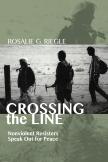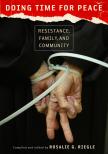Rites of Resistance
Mary Oliver, in her poem “The Morning Paper,” wants to know “What keeps us from falling down, our faces to the ground; ashamed, ashamed?” after we read through countless news stories of “disasters, the unbelievable yet approved decisions.” One way of both grounding ourselves and doing right by the world is to read through Rosalie G. Riegle’s rather stunning collection of resistance stories and then to take action. Though I was familiar with a good number of the people interviewed and their actions, I had no idea that nonviolent resistance to war ran so constantly and deeply in our country and beyond its borders. Even more, I was profoundly moved by the creativity, imagination, courage and sacrifice of those willing to put all on the line, even to the point of risking their lives, for the work of peace. These are the kinds of stories that must be known by a larger audience. Riegle, the steward of such noble stories, has done a work of great service.
The 10 chapters of Crossing the Line: Nonviolent Resisters Speak Out for Peace wend their way from the stories of conscientious objectors during World War II to present day tax resisters. Nestled within these chapters are three interludes, essentially three meditations on the theme of imprisonment. Those who tell their extraordinary stories are ordinary folks. They are primarily lay persons though religious are a notable presence. Most of the “peace people” are inspired to do acts of “divine obedience” by their faith traditions, though a secular grounding for acts of civil disobedience is also offered. The narratives in the text run the gamut from preparation and rationale for the action, the act itself and then to jail or prison time, where the stories told are not simply those of the resisters but also a sampling of the invisible millions who populate our nation’s penitentiaries. Those who tell their stories are primarily white middle class Americans, a point that Riegle acknowledges in the introduction but that is later critically analyzed by several activists.
The text is both challenging and inviting. Its reader may well be aware of the “demonic suction cup” of warfare, as Dr. Martin Luther King Jr. so well described it, but may not be willing to risk jail time in order to stop it. Enter Ralph DiGia, who by the time he died at the age of 94 had devoted just about his entire life to the work of resistance and peacemaking. The “hidden saint,” a name given to him by a Muslim friend with whom he worked in Bosnia, believes that “anybody can do what I did, going step by step as far as they can, to make this a better world and make nonviolence a way of life.” We often need look no farther than our neighbor to see the unjust suffering of the world; the time is now to take this first step into a life of nonviolence. The constant clarion call of these resistance stories brings to mind the counsel of the late Dean Brackley, S.J., who often told those who came to join his work with the impoverished of war-torn El Salvador: “Life is short! Be here 100 percent.”
Ciaron O’Reilly, a veteran Plowshares activist, underscores DiGia’s call to action on what really matters to us: “To be serious about waging peace, we have to take some of the risks of those who wage war.” There is a collective understanding among the resisters that the United States is a war-making state, a nation engulfed in militarism, and one whose culture is permeated by violence. As Meredith Daniels, a conscientious objector interviewed by Riegle puts it, “It seems we almost have a national policy of violence. Our terrifying foreign policy and atomic arsenal is all part of it and I think it gives people a sense of helplessness.”
If there was ever to be a moment of collective and individual paralysis in light of looming political, economic and environmental disasters, that moment is now. While our nation spends over $730 billion each year to sustain its military might and trillions to wage its wars, its people are being made poor in record numbers. While we marvel at our military technology, including the development of the drone, we lose sight of the real human beings we are killing on the ground. While we are fixated on maintaining supremacy and might, we are blind to our irreversible destruction of the earth and of the multitudes of creatures that inhabit it.
Those who share their stories in Riegle’s book are not immune to fear for our world, but they are not paralyzed by it either. By “crossing the line” the way that they do, they actively engage in what School of the America’s resister Rebecca Kanner spoke to during her court appearance: to take seriously “tikkun olam, which is Hebrew for ‘repair of the world.’”
In Doing Time for Peace: Resistance, Family, and Community, the reader has a chance, in its seven chapters, to become immersed in the stories and lives of peacemakers and of their families and communities. To have this opportunity is a delight and a gift. As Daniel Berrigan, S.J., the poet and peace activist, often says, “We know the bad news well enough; tell me, what is the Good News?” The “Good News” is here, in this book, and in the lives and actions of the resisters and peacemakers. Though this book contains much of the thematic content of Crossing the Line, there is an additional emphasis upon the sustenance of community life that is needed to support resistance work as well as upon the real possibility of strains upon family life that resistance may incur. The tales that the resisters have to tell are human stories rather than hagiographic memoirs, and thank goodness for that. After all, who would ever take the recommended step toward a life of peacemaking and nonviolence if those who do so are beyond the pale of humanity? The reader of these fine books may well resonate, then, with the words and actions of Genevieve (Mickey) Allen, who was first arrested when she was 65 years old: “That first time I was scared to death. Scared to death!… But I just knew I was doing the right thing.”
In both books, Riegle allows the resisters to address the intersections of race, class, gender and resistance work. In addition, family and community members speak to the multiple ways they too work for peace by supporting the resister. The deconstruction of the “peace movement” as one of primarily white, male and middle class privilege is a necessary moment in these texts, for it lays bare previously unexamined cultural assumptions about the “higher worth” of particular forms of actions and material realities that may exclude others from taking part in this particular form of resistance. A focus on civil disobedience alone may also ignore the many fine contributions that other individuals and communities have made for the sake of justice and peace. Further, it is well understood and articulated that an individual life of resistance is not possible without the invaluable but often unheralded work of communal and familial support. On this point, Father Berrigan goes as far as to say, “We don’t need heroes. We need communities.” This internal reflection and critique strengthens the texts, for now we may look forward to the further development of communal, multicultural and multi-action forms of resistance and peacemaking in these days of darkness but also of great hope.
This article also appeared in print, under the headline “Rites of Resistance,” in the January 20-27, 2014, issue.









